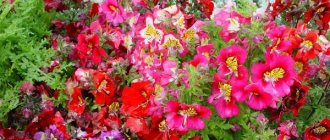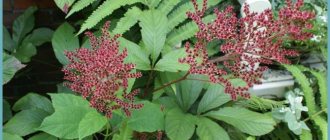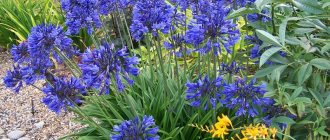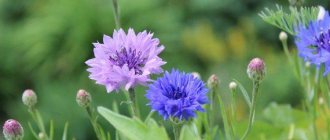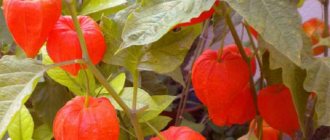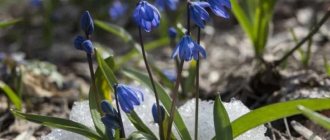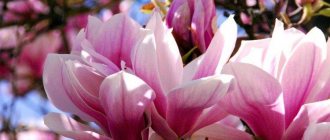Hellebore, or also called helleborus, helleborus, winterberry, is an evergreen, temperature-resistant plant that belongs to a large genus of the Ranunculaceae family. The culture is not afraid of snow and frost. Its homeland is Southern and Central Europe, as well as Western Asia. People know that hellebore was originally used as a raw material for the manufacture of medicines. Its root is still used in some medicinal preparations. But today the decorative properties of the flower are in the foreground.
Plant characteristics
Hellebore is a compact small bush with an average height of no more than 55 cm. Its rhizome is thick and short, numerous roots extend from it. It contains large quantities of cardiac glycosides, as well as essential oils, various vitamins, alkaloids and solanines. The stem is simple and weakly branched.
The basal, leathery leaves of the flower are single, long-petiolate and dissected into pointed, broadly elliptical lobes. At the beginning of growth they have a burgundy or light green tint, and over time they become dark green. In order for the leaves to decorate the garden in winter, they do not need to be pruned in the fall. This is done in the spring, when they already look aesthetically pleasing.
Peduncles bear 1-5 large flowers with a diameter of up to 8 cm of various colors. They can be pink, speckled, white, purple, red, black and light green. The flowers of the plant retain their simple or double shape for a long time. They have 5, less often 6 sepals, which do not wrinkle even after the leaflet opens and seeds fall out of it.
Main types of hellebore
Today, up to 20 species of flowers are known, found in different places on the planet. The flowering period of hellebore varieties varies. For some it begins in early spring. For others, in countries with warm climates, in winter. Still others continue to bloom until summer.
All types of hellebore can be divided into 2 groups:
- By the end of the growing season, plant species of the first group form stems with flower buds at the ends. In order for them to bloom, you need to save the shoots in winter.
- Species of the second group develop shoots with flower buds in spring, not winter.
The culture of flower growers has long included beautiful species of winterweed, on the basis of which their numerous hybrids have been created.
Helleborus niger (Black Wintergrass)
This is one of the most common crops in landscape design. The color of the rhizome formed the basis of its name. A low (up to 35 cm) evergreen bush is known for its beauty. It is distinguished by large (up to 9 cm in circumference) flowers directed upwards. Their color is snow-white, with a pink tint on the outside, which becomes more intense every year. There are varieties with pink flowers. The plant blooms in mid-spring. The leaves are dark green in color and have a hard, dense structure. They are not stored during flowering. The most popular varieties of this species:
- Potter's Will. It has unique white flowers up to 13 cm in diameter.
- Pracox. It is an early bloomer and is one of the first to bloom with soft pink flowers in November.
The black winterer can withstand severe frosts (up to -35 ºС). It is easy to breed, since up to 70 seeds can be collected from one inflorescence.
Helleborus orientalis (Eastern Helleborus)
This winter plant and its hybrids are for lovers of bright colors. Flowers range from pastel pink, creamy white to deep burgundy, almost black. Some petals are marked with dashes or spots of a contrasting shade. They can be decorated with a border or a terry structure. Widely known varieties:
- Double Helen Pink. The flowers of this variety are lilac-pink in color and double in appearance. The culture can reach 0.4 m in height.
- Red Lady. The winter plant is distinguished by purple flowers with a diameter of 10 cm.
- Anemone Picoti. This variety is up to 0.4 m tall. It blooms with light pink or white flowers, along the edge of which there is a thin lilac border. Flowers appear already in mid-spring. It may bloom again in the fall.
The plant is native to countries with mild climates - the Caucasus and Greece. Already in February, some of the Eastern hellebore hybrids begin to bloom.
Helleborus caucasicus (Caucasian helleborus)
Caucasian hellebore is one of the most poisonous species, so it is least often planted in open ground on personal plots. It is most widely used for medicinal purposes. It is found in the Caucasus, in mountainous areas of Turkey and Greece.
The plant blooms from the end of April and continues until mid-June. The flowers are yellowish-green with a pronounced brown tint or white with green, up to 9 cm in circumference. The leaves of the crop are large, shiny, slightly susceptible to damage, up to 15 cm long. Hellebore tolerates winter well.
Plant propagation methods
Wintering varieties are widely used in landscape design. Flowers look great on mixborders, rock gardens, rockeries, forming a bright accent on the garden plot. In winter, hellebore delights gardeners with its unfading greenery. The plant reproduces by seeds, dividing an adult bush. Since this perennial is frost-resistant, it can be grown exclusively in open ground. At home, the winter plant stops flowering.
Propagation by seeds
To grow a winter garden, take fresh planting material. When purchasing, pay attention to the time for collecting seeds; after 6 months they lose their viability. Sow flower planting material into prepared containers with loose, moist soil to a depth of 1-2 cm. When the seedlings have their first leaves, transplant them to a dark place. Move the strengthened plant to a permanent place after 2-3 years. Carry out the transplant in mid-September. The first flowering of a winter plant sown with seeds will begin in 3-4 years.
Dividing the bush
Since hellebore does not tolerate transplantation well and takes a long time to grow, it is recommended to use the vegetative method of plant propagation in rare cases. To divide the bush, choose an adult flower older than 3 years. Plants are transplanted after the flowering period. When planting a winter bush, maintain a distance between plants of about 40 cm. The soil should be loose, moist with good drainage.
When propagating hellebore by dividing the bush, be careful, as this plant is poisonous. A drop of juice causes irritation or burns on the skin. Therefore, when dividing a winter bush, wear gardening gloves and avoid direct contact of the plant with uncovered areas of skin. If flower juice gets on your body, rinse the area thoroughly with running water and consult a doctor.
- Tachycardia - what it is and how to treat it. Causes and symptoms of cardiac tachycardia and why it is dangerous
- How to present yourself at a competition
- How to make a butterfly from beads: a diagram for beginners
Landing area
Having decided on the orth, you need to choose a place where the hellebore will grow. You should take into account the flowering period of the plant, its long lifespan and the fact that it does not like transplanting. Therefore, planting must be approached rationally and responsibly. It is better to plant it in groups. The thickets of the flower restrain weeds and, lying on the ground in a continuous carpet, create an evergreen mulch.
Hellebores do not require special soil. Wet soil is not suitable for planting. Fertile soil rich in rotted leaves and humus is preferable. If it is acidic, then it should be limed.
The flower is a shade-loving plant and does not like direct sunlight. It grows well in the partial shade of trees and shrubs, where the soil is always moist. Fallen leaves will serve as fertilizer and natural mulch for the helleborus. In good conditions, the bush will grow quickly, forming a large number of peduncles and stems.
Conditions for growing hellebore flowers
In nature, this frost-resistant perennial grows in dark places, with good soil ventilation and moderate humidity. To successfully grow hellebore in your garden, create conditions for the plant that are as close to natural as possible. To plant winter huts, choose places protected from direct sunlight and with loose soil. Flowers grow beautifully in the shade of fruit and coniferous trees.
Hellebore thrives in nutritious, non-acidic soil. If the soil on your site is highly acidic, then lime it. To do this, use slaked lime, chalk or dolomite flour. Stagnation of moisture has a detrimental effect on winter flowers. Be sure to take care of the presence of drainage and regularly loosen the soil around the flowers.
Growing a plant
The reproduction procedure is simple and does not require special skills. The plant is grown in three ways:
- self-seeding;
- seeds;
- division.
It is better to grow winter gardens using seed. It can be purchased or collected from previously planted crops. To do this, you do not need to wait until the seed chambers are completely ripe. Because once fully formed, they burst with great force, scattering seeds in different directions. Therefore, it is advisable to collect them when they are not ripe and keep them in a dark bag until they are fully ripe.
Seed material is planted immediately after collection or the next year, since old or overdried material has poor germination. Large seeds of the plant germinate well, but often only the next year after planting. Sow in spring or early autumn in a hole 1-1.5 cm deep.
Only 4-5 years after sowing, hellebore begins to bloom.
You can grow seedlings at home. To do this, seeds are sown in pots in the fall, providing them with constant watering. In the spring, after two leaves appear, the seedlings are pruned. Seedlings grown over the summer are planted in the ground in the fall.
The method of growing a flower by division is the division of a young, healthy mother winter bush into parts. This is done after the hellebore has finished blooming. Full roots are formed for each resulting bush. The new bush is planted in a pre-prepared hole.
Planting holes are made with a depth of at least 0.25 m, maximum 0.3 m. They are located at a distance of 0.3 m to 0.4 m and filled to 1/2 of the depth with compost. After planting hellebore, you need to water it and do this for 3 weeks until the plant takes root.
Cultivation care
Helleborus is an undemanding plant. If you properly organize the care of the hellebore, then the user is guaranteed a soil cover with delicate flowers on the site, which will delight throughout the growing season.
- Trimming. In the spring, all old leaves should be torn off to avoid becoming infected with fungal blight. When the plant stops blooming, young leaves will grow.
- Watering. The crop does not tolerate drying out of the soil and stagnant moisture, so moisturizing should be regular and moderate. After this, the soil needs to be loosened well. You can conserve moisture by mulching with peat or compost.
- Feeding. With the onset of spring, it is good to fertilize the flower with superphosphate and bone meal, which should be added every three months. In dry weather in summer, the soil is fertilized with minerals, this prevents the plant from fungal diseases.
- Pests. Hellebore can be attacked by aphids, hop moth caterpillars, snails, slugs, and mice. Leaves can be treated with insecticidal preparations against aphids and caterpillars, and snails and slugs can be collected. By laying out baits with mouse poison, they get rid of rodents.
- Diseases. Among the diseases, the wintering plant can be affected by powdery mildew, fungal infections, ring spot, and anthracnose. To get rid of diseases, it is necessary to treat the plant with special preparations. For example, with downy mildew, all infected leaves are cut out, and the hellebore is treated with Previkur.
Despite the hardiness and high frost resistance of the crop, in winters with little snow it is better to sprinkle it with spruce branches or leaves so that the winter plant does not freeze out.
Pests and diseases
The most dangerous pests of hellebore are snails, slugs, mice and the ubiquitous aphids.
Occasionally it can be affected by the hop weedworm, whose caterpillars completely gnaw off the roots of the plant. I fight this scourge with the help of insecticides. Hellebore in the snow Sometimes dark spots appear on the leaves of the hellebore, constantly increasing in diameter, this is a sign that the plant is damaged by a fungal infection, Coniothyrium hellebori. This disease spreads most actively in damp and warm weather, so you will have to monitor the hellebore even after it has bloomed. To combat the infection, you need to cut off all the affected leaves and treat the plants themselves with a fungicide, this will help stop the disease.
Bright lush flowers
Remember that diseases primarily affect weak plants! Therefore, try to follow agricultural practices and constantly improve the living conditions of your charges: feed them, water them on time, and so on. Only with proper care will the hellebore thank you with abundant flowering!
